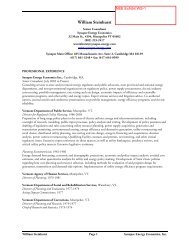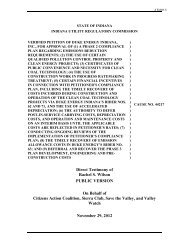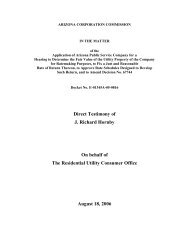Best Practices in Energy Efficiency Program Screening - Synapse ...
Best Practices in Energy Efficiency Program Screening - Synapse ...
Best Practices in Energy Efficiency Program Screening - Synapse ...
You also want an ePaper? Increase the reach of your titles
YUMPU automatically turns print PDFs into web optimized ePapers that Google loves.
Utilities typically have to raise capital (mostly with debt and equity) to <strong>in</strong>vest <strong>in</strong> supplyside<br />
resources, and then they are later allowed to recover the <strong>in</strong>vestment plus the cost of<br />
capital through rates over the life of the asset. For energy efficiency <strong>in</strong>vestments,<br />
utilities are typically allowed to recover the <strong>in</strong>vestment immediately through system<br />
benefit charges, or <strong>in</strong> a very short amount of time through balanc<strong>in</strong>g accounts <strong>in</strong> rates.<br />
Because of this different approach to cost recovery, efficiency <strong>in</strong>vestments are a much<br />
lower f<strong>in</strong>ancial risk to utilities than supply-side resources.<br />
The discount rate applied to the TRC test and the PAC test should reflect this lower<br />
f<strong>in</strong>ancial risk of energy efficiency <strong>in</strong>vestments. We recommend that states use a generic<br />
market <strong>in</strong>dicator of a low-risk <strong>in</strong>vestment, such as the <strong>in</strong>terest rate on long-term US<br />
Treasury bills, when apply<strong>in</strong>g the TRC or the PAC test. This rate is widely accepted as<br />
represent<strong>in</strong>g low-risk <strong>in</strong>vestments, and is straightforward, transparent, and readily<br />
available.<br />
Calculation of Avoided Costs<br />
All of the relevant<br />
avoided costs should be<br />
accounted for, and each<br />
of them should be<br />
calculated correctly.<br />
<strong>Energy</strong> efficiency programs result <strong>in</strong> several types of avoided costs,<br />
and each of them should be <strong>in</strong>cluded <strong>in</strong> the screen<strong>in</strong>g analysis and<br />
calculated correctly. First and foremost, avoided energy and<br />
capacity costs should be based on long-term forecasts that properly<br />
capture the energy and capacity impacts of energy efficiency<br />
resources, account for the structure of the market <strong>in</strong> which the<br />
relevant utility operates, and capture differences between peak and<br />
off-peak periods.<br />
It is also important to account for the cost of transmission and distribution that is avoided<br />
by energy efficiency. In estimat<strong>in</strong>g these costs, program adm<strong>in</strong>istrators should<br />
dist<strong>in</strong>guish between those transmission and distribution costs that can be deferred or<br />
avoided through energy efficiency and those that cannot. Avoided distribution costs tend<br />
to be higher than avoided transmission costs, but avoided transmission costs are<br />
<strong>in</strong>creas<strong>in</strong>g, particularly <strong>in</strong> regions of the country that are expect<strong>in</strong>g significant growth <strong>in</strong><br />
new transmission <strong>in</strong>vestments.<br />
The avoided costs of compliance with environmental regulations should be explicitly<br />
accounted for <strong>in</strong> the Societal Cost test, the TRC test and the PAC test. The costs of<br />
environmental compliance will eventually be passed on to ratepayers, and those that can<br />
be avoided should be <strong>in</strong>cluded as part of the avoided costs of energy efficiency. Recent<br />
environmental regulations from the US Environmental Protection Agency are likely to<br />
<strong>in</strong>crease the costs of environmental compliance, and may require the retirement of many<br />
fossil-fired generation units, which will have significant implications for energy efficiency<br />
avoided costs.<br />
Similarly, there are several exist<strong>in</strong>g and anticipated <strong>in</strong>itiatives<br />
at the federal, regional and state levels to curtail the emissions<br />
of greenhouse gases (GHG). <strong>Energy</strong> efficiency is by far the<br />
lowest-cost and most plentiful option for meet<strong>in</strong>g these<br />
<strong>in</strong>itiatives. In order to meet climate change regulations at the<br />
lowest cost, the full avoided cost of comply<strong>in</strong>g with current and<br />
future GHG <strong>in</strong>itiatives should be accounted for <strong>in</strong> screen<strong>in</strong>g<br />
energy efficiency programs. In sum, energy efficiency should<br />
be evaluated on an equivalent basis with other options for<br />
| 4 <strong>Best</strong> <strong>Practices</strong> <strong>in</strong> <strong>Energy</strong> <strong>Efficiency</strong> <strong>Program</strong> Screen<strong>in</strong>g | www.nhpci.org<br />
In those states and regions<br />
with climate change<br />
requirements, energy<br />
efficiency should be<br />
evaluated on an equivalent<br />
basis with other options for<br />
mitigat<strong>in</strong>g greenhouse gases.







